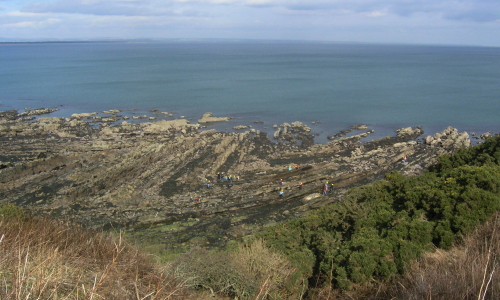![]() If you’re lucky enough to be a geologist, life is one continuous serendipity. Take my view from the cliffs as I wandered along the Scottish coast south of St Andrews over the weekend:
If you’re lucky enough to be a geologist, life is one continuous serendipity. Take my view from the cliffs as I wandered along the Scottish coast south of St Andrews over the weekend:
Hopefully it doesn’t take too much squinting to spot the lovely plunging folds, exposed on the wave-cut platform along the shore. The alternating sequence of hard sandstones and softer shales make the deformed beds very easy to trace. The fold axes appear to be plunging northwards, out to sea.
Here’s another one a little further down the coast. I was amused to find that this one was covered in infant geologists (easily identifiable by their distinctive hard hats) who were probably puzzling over the mysteries of compass-clinometers and stereonets.
And here’s yet another. I’m sure you can make do without the virtual orange pen this time.
When I got back home, I discovered that Google Earth shows this whole section in all its buckled glory:

Plunging folds are formed by two deformation events: the crust is squashed in one direction, forming the folds, then stress oriented in a completely different direction warps the fold axes away from the horizontal. These rocks are Carboniferous, about 320 million years old, so are too young to have been folded in the Caledonian orogeny which marked the closure of the Iapetus Ocean; when these rocks were deposited, that was getting on for 100 million years in the past. However, the Variscan orogeny, associated with the amalgamation of the supercontinent Pangaea (and, in local terms, the collision of France and Spain with Southern England), was fast approaching on the geological horizon, and since it involved lots of different continental fragments colliding with each other at slightly different times, it could well have resulted in multiple, differently oriented episodes of deformation.
It’s nice to speculate, but of course, the folds are still beautiful regardless of how or when they formed.

Categories: outcrops, photos, structures, tectonics
Tags: folds outcrops photos Scotland








Comments (4)